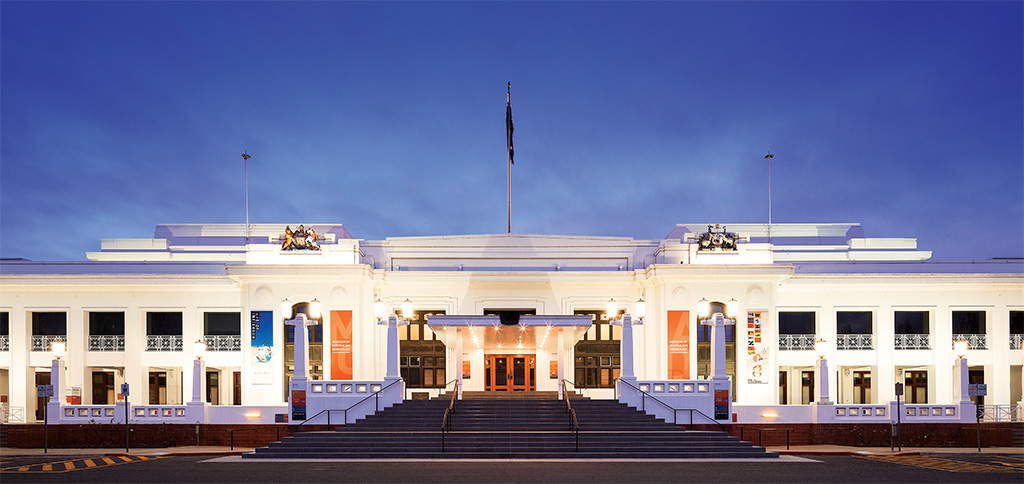
Order in the House
Text:/ Derek Powell
Luis Miranda is a man who enjoys his work: “I just love solving problems,” he declares. Luis is an audio consultant with Auditoria, a specialist consultancy whose work covers everything from Live Events (think: Olympics opening ceremonies) to major venue sound systems (think: the renewal of the Joan Sutherland Theatre at the Sydney Opera House and Bankwest Stadium at Parramatta). Luis has a PhD in Acoustics and relishes the challenge of coaxing good sound out of difficult acoustical environments. Throw in a few extra constraints like a heritage-listed building and he’ll happily rise to the challenge.
This particular challenge was three spaces within a building that most of us will instantly recognise — Old Parliament House in Canberra, the most significant building in Australia’s democratic history. Those three spaces are the most iconic in the building: The House of Representatives Chamber; the Senate Chamber; and Kings Hall, “the huge echoing crossroads that was the beating heart of the House”.
DEMOCRACY HUB
The House has been transformed into the Museum of Australian Democracy (MoAD) that now daily hosts educational tours for school groups and tourists, interpreting the history of our democratic institutions while preserving the fabric of the wonderful old building that has been witness to the most pivotal moments in our history. MoAD’s aim was to bring 21st century audiovisual capabilities to this near century-old building.
As part of the process, the Museum’s Head of Facilities Chris Grebert and Project Manager Warwick Bartlett sharpened that broad aim by bringing together the needs of the different stakeholders — education, tour groups, events, and, of course, the heritage requirements for the installation.
The most problematic area was Kings Hall, the splendid space that sits between the Senate chamber on one side and the House of Representatives chamber on the other. Its high-coffered ceiling, plaster walls and highly polished parquet floor make a grand statement but those very features also create an acoustic that makes sound reinforcement extraordinarily challenging. With the hall now heavily in demand for all manner of functions, the brief from the museum was to design and install a flexible sound reinforcement system that could provide clear, articulate speech, while remaining virtually invisible.
Luis knew that the system would need to deliver even coverage across the 16m width of the room while keeping sound away from the multiple reflective surfaces that could easily create a giant echo chamber. A distributed speaker system would be out of the question as multiple speakers would badly impact the heritage values. But there was one possibility that ticked the right boxes: a line array with digital beam steering.
TEAM DETAILS
Consultants: Auditoria
Luis Miranda Jofre PhD – Senior Consultant
Scott Willsallen – Director
Integrators: Sound Advice
Norman Korte – director
Stewart Henderson – project manager
MoAD: Chris Grebert – Head of Facilities, Capital Projects & IT
Warwick Bartlett – MoAaD Project Manager
Mitch Bracken – Technical Officer
Daniel Iglewski – ICT coordinator
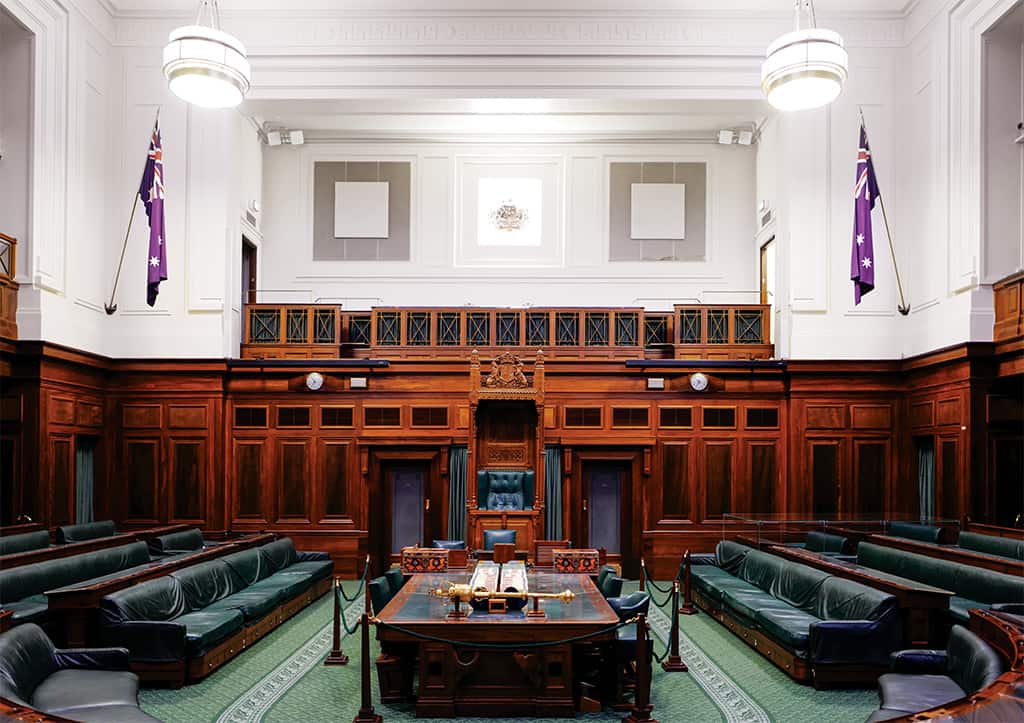
STAYING ON BEAM
As Luis started the design exercise, he knew that digital beam steering would be a powerful tool but the architectural limitations were quite significant. From a heritage point of view, the speakers in Kings Hall needed to be unobtrusive and away from major sight lines. The museum’s heritage department would have to approve all installations and they provided support in identifying solutions that would have the least impact on the fabric of the building. The ideal position would be high up in the coffered ceiling area, but that location would require a speaker with exceptional beam steering capability.
Luis whittled down the possible speaker systems to a choice of three. The contractor specified that every part of the installation had to be demonstrated and approved to ensure the outcome would be adequate, so Luis set about trialling the speakers in situ. He brought in a portable high-reach pallet lifter which could position the speakers at the right height to closely simulate various options for the final speaker position. He then took a series of measurements in the space to determine the impulse response for each of the speakers in a number of positions.
The result was a pleasant surprise: “When we tested using the Fohhn DLI-230 speaker, we found that its beam forming worked really well,” Luis recalled. “It proved that locating a speaker high up in the coffered section could deliver the coverage we needed while also being more in line with the Heritage Conservation Guidelines.”
The final installation used three pairs of the DLI-230’s smaller brother, the DLI-130 which fit perfectly in the recessed ceiling area. The DLI-130’s useful frequency response extends down to 60 Hz which is extraordinary for a box running eight, four-inch drivers. As a result, subs weren’t needed since the requirement in Kings Hall was primarily for speech reinforcement.
The three speaker pairs allow for functions to be set with the stage or lectern in different positions — at the front, on the left, or the right side of Kings Hall. Only one pair will generally be in use at any one time with configuration handled by a Q-Sys DSP which takes care of all the audio routing in the installation. The correct speaker pair for each orientation is selected using a Crestron control system, accessed by a discreet wall-mounted touch panel or an iPad running Crestron’s XPanel software.
ACOUSTICS: LET THAT SOAK IN
However, the active electronics and speakers could only ever be part of the solution. The initial brief acknowledged the existing acoustic problems and Luis’ preliminary measurements had confirmed that some absorption would be needed to tame the acoustics. The reverberation time was around four seconds and during the museum’s daily opening times, noise from the tour groups in the wings to either side echoed right across the space. But what could be done without impacting the heritage values and distinctive architectural features of this space?
“That was a little bit tricky,” Luis admitted. “We did the required calculations and then tried to find a product that looked right — could be colour matched, and performed as well as possible for what we were permitted to do”.
Luis’ solution was ingenious and virtually invisible. He had broad-band fabric-covered absorber panels made up to the precise dimensions of the decorative plaster panels on the walls. Colour matched to the plaster, they are visually indistinguishable from the architecture but have a valuable effect on acoustics.
“It has had a really good impact on intelligibility in the room,” Luis noted. “It shaved about a second off the reverberation time. At 1kHz, the measured reverberation has come down from four seconds to 2.7s, which is much more manageable.”
“”
The real stars of the show are the Fohhn DLI-130 column arrays installed discreetly up and out of the way in the coffered section of the architecture.
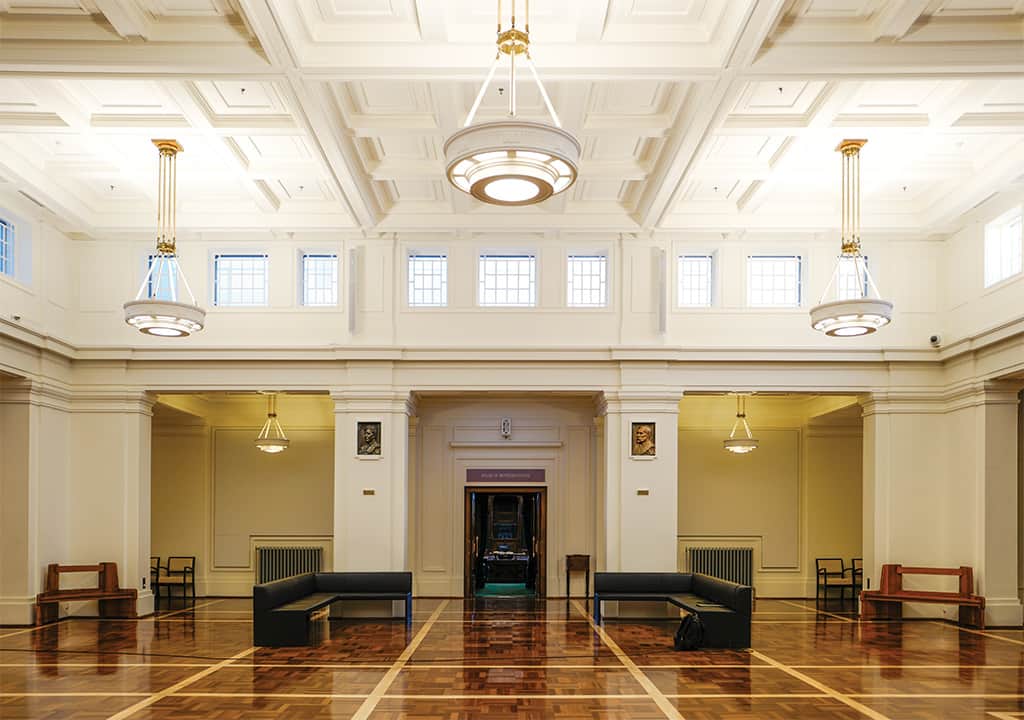
ECHO CHAMBERS
With Kings Hall tamed, attention turned to the Parliamentary chambers. The old House of Representatives chamber, once the scene of many fiery debates across the dispatch boxes, was now regularly filled by visiting school groups learning about parliamentary procedures and processes. The first requirement here was for a sound reinforcement and hearing assistance system for the use of teachers and museum guides. In addition, because the space was heavily used for functions and commercial presentations, it needed a lectern, dual video projection flanking the Speaker’s chair and a full-range program sound system.
The audio, projection and hearing assistance arrangements had to cover every one of the 128 green leather members’ seats as well as the 50-seat public gallery while making the absolute minimum impact on the fabric of the space and remaining discreet to the point of near-invisibility.
Perhaps surprisingly, although the chamber had been fitted with microphones for Parliamentary broadcasts, there had never been a PA system, so Luis needed to start from scratch with no ready-made cabling conduits, nor any established speaker recesses where new infrastructure might be hidden. Once again, the ideal solution was the narrow, low-profile Fohhn column arrays, this time using the larger DLI-230s mounted to either side of the old Press Gallery.
Luis created presets that allowed each speaker system to deliver two different beams at once. One beam covers the floor of the chamber while the second directs sound only to the public gallery which can be switched on whenever that area is in use. To allow full-range sound, two matching Fohhn subwoofers are floor mounted behind the railing of the Press Gallery, adjacent to the columns but out of sight. Because the gallery is not open to the public, the speakers did not need any fixings so there was no effect on the heritage woodwork.
VOTE FOR PROJECTION
The projection system was required for use with visiting school groups and also for occasional corporate presentations. Again, any equipment added to the space needed to be as unobtrusive as possible and to be removable without damaging the fabric of the chamber. Integrators, Sound Advice, responded with some innovative mounting solutions to meet this demanding brief. They concealed twin Panasonic RZ670 laser projectors in the public gallery and devised a discreet mirror system to project across the chamber. On the opposite wall, twin retractable screens were suspended from the Press Gallery balcony. The screen cases were colour matched to the woodwork so they virtually disappeared when not in use.
For functions, HDMI inputs to the projectors are available at the lectern positions with signal transport provided by Crestron’s DM-NVX-350 video-over-IP solution. A Shure ULXD series lectern mic and dedicated receiver keeps cabling to an absolute minimum, providing functionality without intruding on the unique character of the chamber. Once again, a Crestron TSW-760 touch panel allows function staff to set-up and control the presentation facilities.
STEERED COLUMN ARRAYS
Column speakers, with vertically stacked drivers were popular in sound system design from the 1950s thanks to their predictable directivity and relatively long throw. What’s more, stacking drivers produces a narrow, low profile form factor that can blend into a range of architectural features making column designs unobtrusive. More recently, manufacturers have used small, closely-spaced drivers in column speakers to create a line array source which can provide high directivity over a relatively wide frequency range.
It has been known for some time that introducing a progressive delay to the sound emanating from each speaker in a column line array has the effect of steering the beam down (if the upper drivers transmit earlier than successive lower drivers). This has the same result as tilting the box forward but the steerable array enclosure can continue to sit flush against the wall, retaining its inconspicuous appearance.
Beam steering was difficult and expensive with analogue technology but with the appearance of DSP chips and small form factor amplifiers it has become practical to produce steerable arrays with every driver individually powered. Speaker columns can sit flush while their output is directed very precisely away from walls and ceilings that will create unwanted reverberation and echo. Steerable arrays can also provide very even SPL levels over quite a long throw, making them highly desirable in sound reinforcement applications.
Today, steerable beam column arrays are available from a number of manufacturers including Meyer Sound, Tannoy, Renkus-Heinz, JBL, Fohhn and others.
CMI (Fohhn): (03) 9315 2244 or cmi.com.au
GUIDING HAND
The guides who take the regular school tours through the museum take control of each space they enter using an iPad running Crestron XPanel. In each room, the system allows the guides to tune the radio mic receiver to their own Shure lapel mic transmitter and to trigger educational video content on the projection system. Behind the scenes, BrightSign video players provide content via the network to the projectors in each space. Out in Kings Hall, other automated BrightSign players provide interpretive video content to projectors that use the acoustic panels as a screen surface.
Of particular importance in the project was the comprehensive hearing assistance system, which is used for both tour groups and functions across the Kings Hall and the chambers. Two separate systems provide flexible options for any patron who enter the spaces. First, all audio (microphones and video program sound) is directed to a Williams AV hearing hotspot. Patrons can use an app downloaded to their own smartphone to tune in to sound in each space via wi-fi and then use their own earbuds, headphones or Bluetooth system. For patrons who don’t use a smartphone, pre-configured iPods with personal neck loops or headphones are available from the museum staff.
The second system installed in the spaces uses the ‘Roger’ protocol devised by hearing aid manufacturer Phonak which is already popular in a number of schools. An RF beacon located at the entrance to each room alerts users of certain Phonak hearing aids that a direct connection is available. It allows the aids to automatically tune in to the audio from a local Phonak base station connected to a feed from the room sound system.
ANSWER TIME
Many seasoned AV practitioners would rather avoid jobs that combine poor acoustics with the constraints of working in heritage listed buildings. Luis, though, enjoys putting his years of university study in audio and acoustics to good use.
“Solving acoustic problems in difficult spaces is something I like to do,” he confided. “Whether I am working in Kings Hall or Bankwest Stadium, I’m trying to provide the best clarity in a challenging environment. So understanding not only loudspeakers but acoustics helps a lot.”
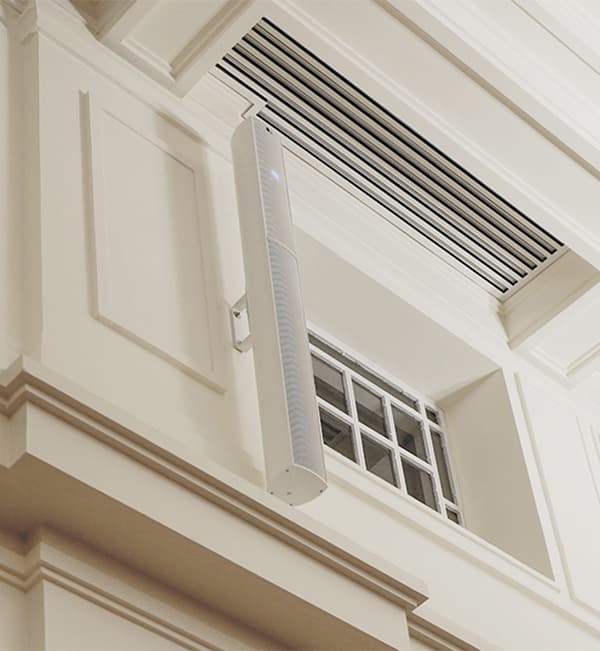
EQUIPMENT LIST
Audio
Loudspeakers (Kings Hall): 6× Fohhn DLI-130 with signal distribution via Fohhn AM-40
Loudspeakers (Chambers): 2× Fohhn DLI-230 per room
Subs (Chambers): 2× Fohhn XS-30 per room
Central router & processor: QSC Q-Sys Core 510i
Distributed audio IO: QSC Q-Sys I/O 8 Flex
Hearing augmentation via WiFi: Williams Sound HHS132D complete with pre-configured iPhones and personal neck loops or headphones
Hearing augmentation via Roger protocol: Phonak Roger BaseStation (one per room)
Hearing augmentation tuner via Roger: Phonak Wall Pilot (one per room)
Microphone receivers: Shure ULXD series,
6 channels in Kings Hall, 4 in each chamber
Microphones: ULXD1 plus WL183, ULXD8 plus MX410/C ULXD2 plus B87A.
Portable console: Yamaha QL1 complete with RIO1608-D frame
Control
Central controller: Crestron CP3
Touch panels: Crestron TSW-760, one in each room
iPad control: via Crestron app
Video
Signal distribution: Crestron DM-NVX-350
(one per remote input and one per remote output)
Signal distribution: Crestron DMF-CI-8, one at Kings Hall
Configuration and processing: Crestron DM-XIO-DIR-80
Video playback: BrightSign XD234, (four separate devices in Kings Hall, one per chamber)
Projectors: Panasonic PT-RZ670BU
Screens: Screen Innovations Solo Pro
Acoustic Treatment: Kvadrat Soft Cells Broadline Broadband absorption panels

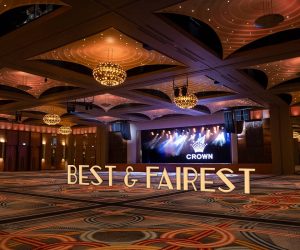




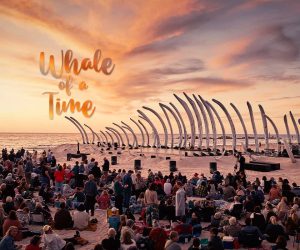




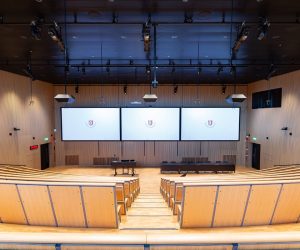



RESPONSES